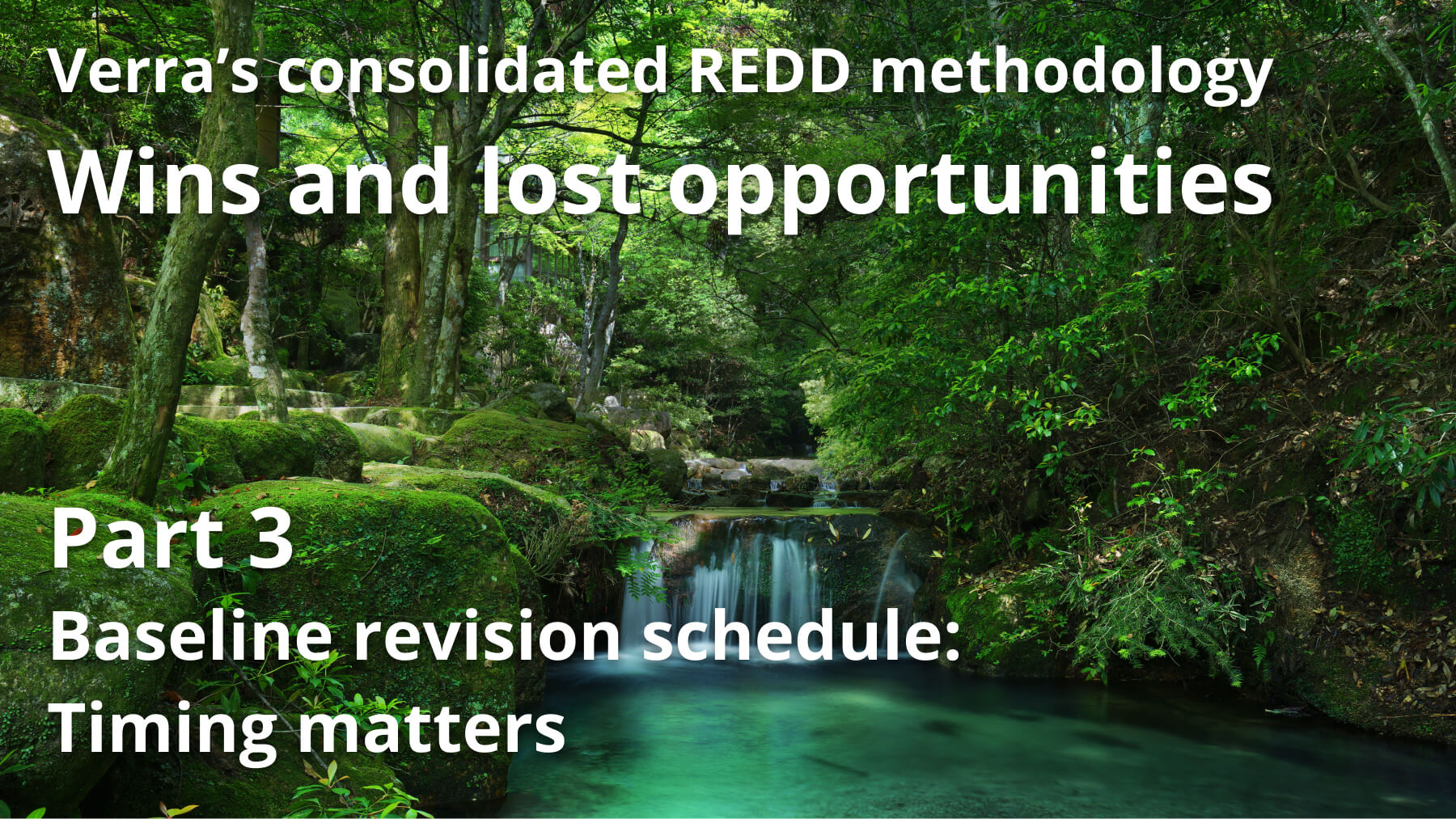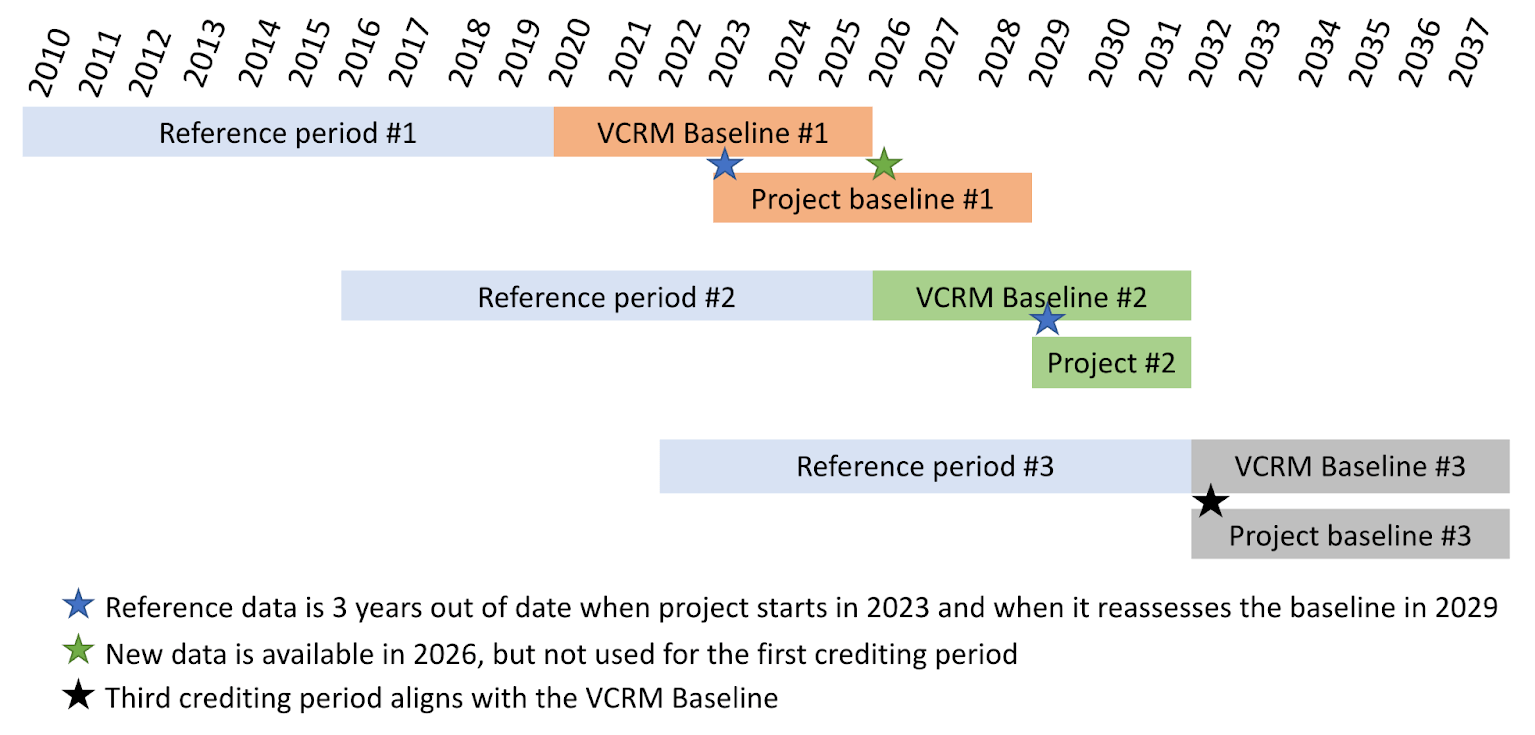
Verra’s consolidated REDD methodology: Wins and lost opportunities, in four parts
Part 1: Emissions monitoring: Under the Radar
Part 2: Baselines: All We’ve Been Waiting For?
Part 3: Baseline revision schedule: Timing matters
Part 4: Permanence and Additionality: Waiting in the Wings
One important win…
One of the best improvements in Verra’s consolidated REDD methodology (VCRM) is that project baselines must be revised every six years. This is a big improvement on current methodologies that allow a baseline to be used for 10 years. In many countries that host REDD projects, forest dynamics can change significantly in a short period of time such that setting a “business as usual” baseline for a decade is often much too long to provide relevant results.
…but also one concern.
The jurisdictional baseline that is used to allocate expected forest loss to project baselines is set by Verra for six calendar years (e.g. 2020 to 2026). Projects may not necessarily start on the same cycle as Verra. If they do not, they will end up using a baseline that is not derived from the most recent deforestation data for their jurisdiction and will lock-in a baseline for six years using old deforestation data.
Paraphrasing Verra’s example1, if the jurisdictional baseline starts in 2020, and a project registers with a 2023 start date, the project will use the baseline allocated in 2020 for six years (three years beyond the official revision which would happen in 2026). So for 2023-2029, the project will be using data from 2010-2019, data that will be up to 19 years old by the end of the project’s first crediting period. Calyx Global will assess that baseline against data from the years immediately prior to the project’s start (e.g. 2018-2022) because more recent data better represents what is happening on the ground. Better baseline data will be available to the project in 2026, when the next round of Verra baselines is created, but the project will not be required to use it until 2029.
Figure: Verra’s six-year baselining approach
From 2029-2032, the project will be using the official updated baseline provided by Verra in 2026 based on reference data from 2016-2025. In 2029, that baseline will be three years out of date, from the project’s perspective, and 70% of the data from which the baseline is determined will be over five years old; 30% will be 10 or more years old.
Finally, in 2032, after the project’s first ten years, the project will synchronize with the Verra baseline schedule. The project will be required to use the newest allocation based on reference data from 2022-2031.
The best option for the atmosphere would be for Verra to use dynamic baselines that are updated annually, based on actual deforestation in the jurisdiction year-on-year. This would be determined ex-post, and likely the most accurate approach to generating “business as usual” REDD baselines. However, project developers may feel this is not practical due to the uncertainty on the volume of credits they may generate. Whether investors would be willing to manage the risk is also uncertain.
Another option would be to create a rolling six-year baseline that updates every year. Alternatively, it could be updated every two or three years. Revising the jurisdictional baseline on a rolling basis would create a more accurate baseline for the project than waiting every six years. However, it could create mismatches at the jurisdictional level: in the same year, different projects could potentially be evaluated against an allocation derived from different baselines. The allocations might not all add up.
Two simpler options exist. First, if projects enter Verra’s jurisdictional baseline setting cycle in an off year, they could be required to adopt the newer baseline as soon as it is available (in the example above, in 2026 rather than waiting until 2029). Second, Verra’s cycle could be shorter: three years instead of six. If projects come in ‘off cycle,’ even under VCRM’s current rules, they would get on track with a baseline derived from the most recent deforestation data more quickly.
Dynamic baselines may be impracticable, and even a rolling six-year baseline may be too difficult to administer. Nevertheless, Calyx believes the Verra baseline should be revised more than once every six calendar years to avoid locking in out-of-date project baselines. We understand the time involved in preparing project documents and project developers’ need for certainty during that process. We also understand the need for certainty at the jurisdictional level to get the crediting right. We believe both types of need could be satisfied with a revision schedule that is more frequent than once every six years.
- https://verra.org/wp-content/uploads/2023/04/MD00XX-Module-for-Avoiding-Unplanned-Deforestation-2023.04.12-public-draft-1-1.pdf page 5.
Get the latest delivered to your inbox
Sign up to our newsletter for the Calyx News and Insights updates.
